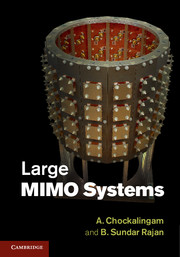Book contents
- Frontmatter
- Dedication
- Contents
- Preface
- Acknowledgments
- Abbreviations
- Notation
- 1 Introduction
- 2 Large MIMO systems
- 3 MIMO encoding
- 4 MIMO detection
- 5 Detection based on local search
- 6 Detection based on probabilistic data association (PDA)
- 7 Detection/decoding based on message passing on graphical models
- 8 Detection based on MCMC techniques
- 9 Channel estimation in large MIMO systems
- 10 Precoding in large MIMO systems
- 11 MIMO channel models
- 12 Large MIMO testbeds
- Author index
- Subject index
- References
7 - Detection/decoding based on message passing on graphical models
Published online by Cambridge University Press: 18 December 2013
- Frontmatter
- Dedication
- Contents
- Preface
- Acknowledgments
- Abbreviations
- Notation
- 1 Introduction
- 2 Large MIMO systems
- 3 MIMO encoding
- 4 MIMO detection
- 5 Detection based on local search
- 6 Detection based on probabilistic data association (PDA)
- 7 Detection/decoding based on message passing on graphical models
- 8 Detection based on MCMC techniques
- 9 Channel estimation in large MIMO systems
- 10 Precoding in large MIMO systems
- 11 MIMO channel models
- 12 Large MIMO testbeds
- Author index
- Subject index
- References
Summary
Probability theory and graph theory are two branches of mathematics that are widely applicable in many different domains. Graphical models combine concepts from both these branches to provide a structured framework that supports representation, inference, and learning for a broad spectrum of problems [1]. Graphical models are graphs that indicate inter-dependencies between random variables [2],[3]. Distributions that exhibit some structure can generally be represented naturally and compactly using a graphical model, even when the explicit representation of the joint distribution is very large. The structure often allows the distribution to be used effectively for inference, i.e., answering certain queries of interest using the distribution. The framework also facilitates construction of these models by learning from data.
In this chapter we consider the use of graphical models in: (1) the representation of distributions of interest in MIMO systems, (2) formulation of the MIMO detection problem as an inference problem on such models (e.g., computation of posterior probability of variables of interest), and (3) efficient algorithms for inference (e.g., low complexity algorithms for computing the posterior probabilities). Three basic graphical models that are widely used to represent distributions include Bayesian belief networks [4], Markov random fields (MRFs) [5], and factor graphs [6]. Message passing algorithms like the BP algorithm [7] are efficient tools for inference on graphical models. In this chapter, a brief survey of various graphical models and BP techniques is presented.
Information
- Type
- Chapter
- Information
- Large MIMO Systems , pp. 123 - 168Publisher: Cambridge University PressPrint publication year: 2014
